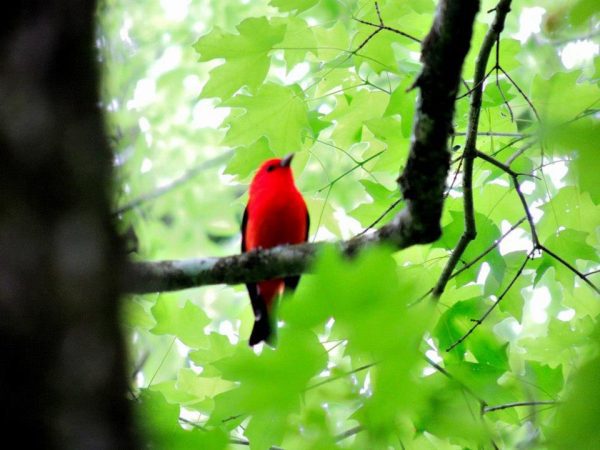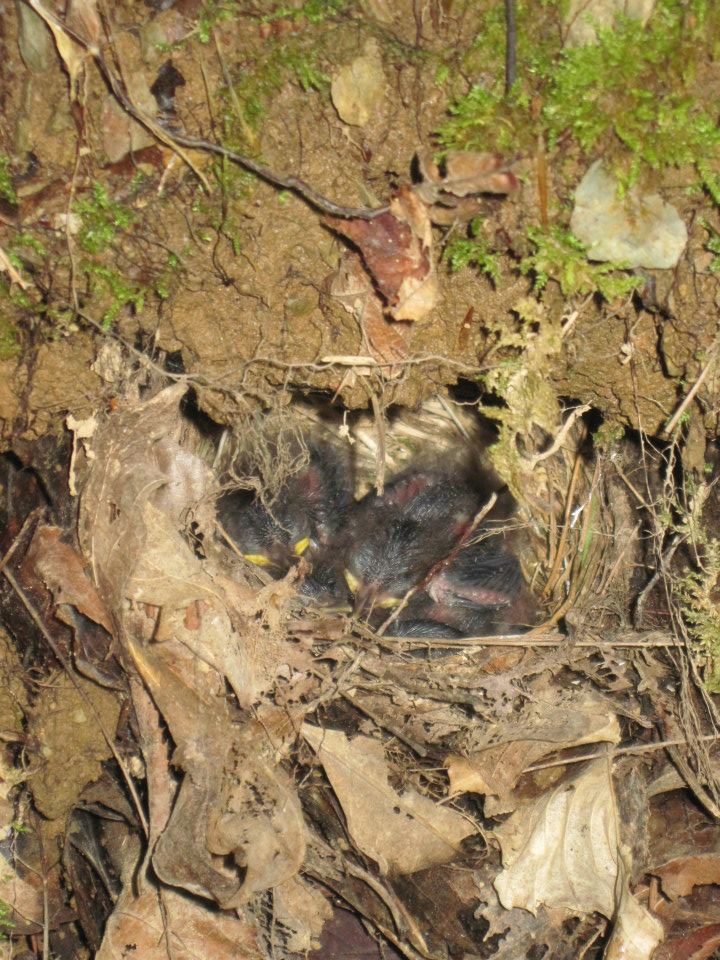A walk in the woods

Have you ever wondered what you might see if you spent a whole weekend outside just looking? How about if you could also bring a few expert field biologists and naturalists with you? Well, that’s what we were able to at The LandTrust for Central North Carolina’s first Uwharrie Naturalist Weekend in May.
More than 50 people came for the hikes, canoe trip and camping event. In two days and one night we spotted more than 20 bird species, at least 14 species of wildflowers in bloom, and 6 herp species (“herps” from herpetology, the study of amphibians and reptiles), including one rather large canebreak rattlesnake (also known as a timber rattlesnake), which most people thought was incredibly awesome, although a few were a little leery of future hikes in the area. The snake itself seemed rather disinterested in the whole affair, having apparently recently gorged himself as given away by the large bulge in his abdomen.
This event focused on neotropical migratory breeding birds, of which we heard and saw at least 14 species, including such favorites as scarlet tanager, black-and-white warbler, and red-eyed vireo. A yellow-throated warbler put on an excellent show, posing for pictures less than 10 feet from us. We got birds to fly in to us by using apps on our smart phones that play their songs, and, as they are territorial, they will come to investigate. One call resulted in two prothonotary warblers coming in and then sparring with one another over the turf.
 Another highlight was finding the nest of a Louisiana waterthrush, complete with three babies. This bird nests along streams in deciduous forests, and we found this one as we were flipping rocks in a beautiful clear stream with cascades and pools. We actually had walked right up on the nest when the mother came in with food in her mouth, resulting in our having to back up twice to see where she was taking it. We were rewarded by finding her sweet little nest right in the side of the stream bank.
Another highlight was finding the nest of a Louisiana waterthrush, complete with three babies. This bird nests along streams in deciduous forests, and we found this one as we were flipping rocks in a beautiful clear stream with cascades and pools. We actually had walked right up on the nest when the mother came in with food in her mouth, resulting in our having to back up twice to see where she was taking it. We were rewarded by finding her sweet little nest right in the side of the stream bank.
These migrant birds fly here from thousands of miles away in Central and South America. They are only here for breeding season, April to August. So why would a tiny bird make the effort to fly all that distance? Well, these birds are diurnal (they find food during the day), and when they have babies they obviously need to be able to find all the food they can. So they have their young here in our summer, because we have more hours of daylight this time of year than the tropics. We also have abundant insects, fruit and nectar in the summer, and potentially, fewer predators. Many of these birds breed in nests located directly on the ground.
Neotropical migrants weren’t the only birds seen. As we were enjoying lunch by the river, a broadwing hawk performed a courtship display. Flying even higher, an osprey, red-tailed hawk, and turkey vulture circled simultaneously overhead. During our canoe trip a great blue heron accompanied us most of the way, and we rescued a turtle known as an eastern river cooter that had become lodged between logs on the stream bank, setting it free into the river after giving it a closer look.
Blooming wildflowers included dwarf larkspur, jack-in-the-pulpit, and foamflower. Mountain laurel was just beginning to bloom, and it towered above us in places, making a remarkable natural arbor.
The event took place on The LandTrust’s Low Water Bridge Preserve, a 1,300-acre property on the Uwharrie River in Montgomery County. This unique property has more than 5 miles of river frontage on both sides of the river and is largely mature hardwood forest habitat. Many beautiful streams flow through the property, which boasts an abundance of wildlife. The LandTrust purchased the preserve in 2006, thanks to funds from private donors and the State’s Ecosystem Enhancement Program. Special thanks to our leaders this weekend, ornithologists John Gerwin and Brian O’Shea with the N.C. Museum of Natural Sciences in Raleigh. And thanks to all who came out. If you missed the event this time, mark your calendars for next year – as you never know what you’ll find on a walk in the woods.
Scroll below to see more photos from the event. Photos were taken by Crystal Cockman, John Gerwin, Laura Domingo and Scott Pohlman. The photos were made available by the LandTrust of Central North Carolina.
Nature’s bounty seen during a walk in the woods
[view:slideshow2=block_1]